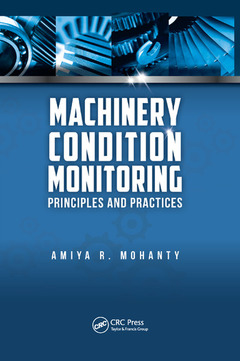Machinery Condition Monitoring Principles and Practices
Auteur : Mohanty Amiya Ranjan

Find the Fault in the Machines- Drawing on the author?s more than two decades of experience with machinery condition monitoring and consulting for industries in India and abroad, Machinery Condition Monitoring: Principles and Practices introduces the practicing engineer to the techniques used to effectively detect and diagnose faults in machines. Providing the working principle behind the instruments, the important elements of machines as well as the technique to understand their conditions, this text presents every available method of machine fault detection occurring in machines in general, and rotating machines in particular.
A Single-Source Solution for Practice Machinery Conditioning Monitoring- Since vibration is one of the most widely used fault detection techniques, the book offers an assessment of vibration analysis and rotor-dynamics. It also covers the techniques of wear and debris analysis, and motor current signature analysis to detect faults in rotating mechanical systems as well as thermography, the nondestructive test NDT techniques (ultrasonics and radiography), and additional methods. The author includes relevant case studies from his own experience spanning over the past 20 years, and detailing practical fault diagnosis exercises involving various industries ranging from steel and cement plants to gas turbine driven frigates. While mathematics is kept to a minimum, he also provides worked examples and MATLAB® codes.
This book contains 15 chapters and provides topical information that includes:
- A brief overview of the maintenance techniques
- Fundamentals of machinery vibration and rotor dynamics
- Basics of signal processing and instrumentation, which are essential for monitoring the health of machines
- Requirements of vibration monitoring and noise monitoring
- Electrical machinery faults
- Thermography for condition monitoring
- Techniques of wear debris analysis and some of the nondestructive test (NDT) techniques for condition monitoring like ultrasonics and radiography
- Machine tool condition monitoring
- Engineering failure analysis
- Several case studies, mostly on failure analysis, from the author?s consulting experience
Machinery Condition Monitoring: Principles and Practices presents the latest techniques in fault diagnosis and prognosis, provides many real-life practical examples, and empowers you to diagnose the faults in machines all on your own.
Introduction. Principles of Maintenance. Fundamentals of Machinery Vibration. Rotordynamics. Digital Signal Processing. Instrumentation. Vibration Monitoring. Noise Monitoring. Electrical Machinery Faults. Thermography. Wear Debris Analysis. Other Methods in Condition Monitoring. Machine Tool Condition Monitoring. Engineering Failure Analysis. Case Studies. Bibliography. Appendices. Index.
Amiya R. Mohanty has been a faculty member at the Indian Institute of Technology Kharagpur, India, since 1996, and is currently a professor of mechanical engineering. He has a B.ScEngg (Hons) in mechanical engineering from the National Institute of Technology, Rourkela. He holds a master’s degree in machine design specialization from the Indian Institute of Technology, Kharagpur, and a PhD in the area of noise control from the University of Kentucky in the United States. Prof. Mohanty is a fellow of the Acoustical Society of India. He has consulted more than 50 companies, and published more than 100 journal articles.
Date de parution : 07-2017
15.6x23.4 cm
Date de parution : 12-2014
15.6x23.4 cm
Thèmes de Machinery Condition Monitoring :
Mots-clés :
Acoustic Emission, Anechoic Chamber, Base Excitation, Bath Tub Curve, Bearing Defects, Bend Pulley Failure Analysis, Bent Shaft, Bowed Shaft, Calibration Principles, Cepstrum Analysis, Chemical Composition Measurement, Computer-Aided Data Acquisition, Condition Monitoring in Large Rotor Systems, Construction of an Electric Motor, Cracked Shaft, Data Recorders, Digital Signal Processing, Eccentricity Detection, Eddy Current Testing, Electrical Machinery Faults, Enterprise Resource Planning, Exper
